SKODA OCTAVIA 2016 3.G / (5E) Manual Online
Manufacturer: SKODA, Model Year: 2016, Model line: OCTAVIA, Model: SKODA OCTAVIA 2016 3.G / (5E)Pages: 324, PDF Size: 48.85 MB
Page 81 of 324
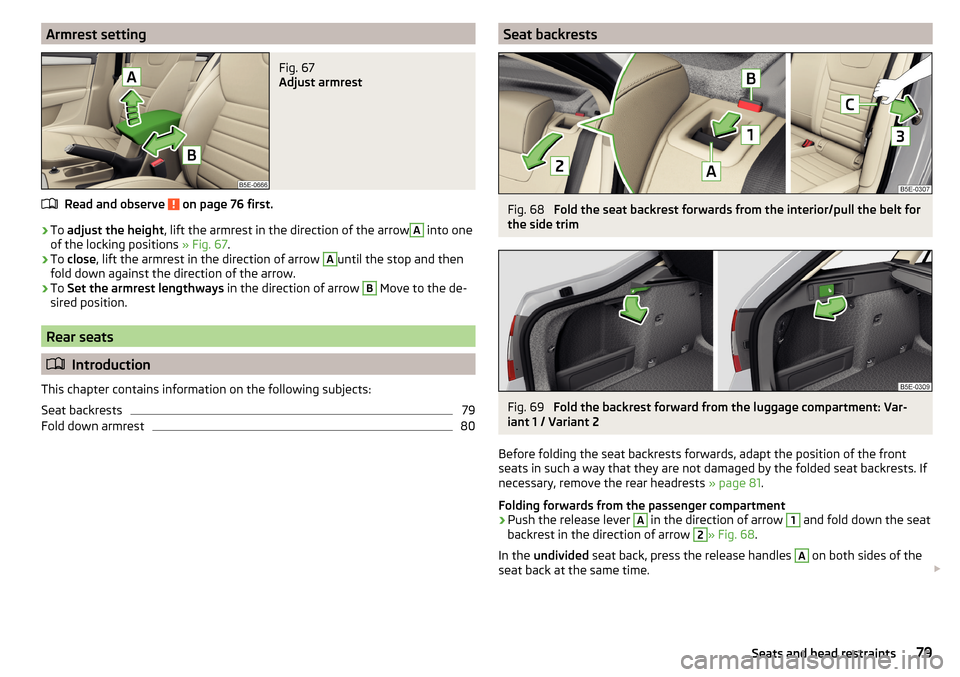
Armrest settingFig. 67
Adjust armrest
Read and observe on page 76 first.
›
To adjust the height , lift the armrest in the direction of the arrow
A
into one
of the locking positions » Fig. 67.
›
To close , lift the armrest in the direction of arrow
A
until the stop and then
fold down against the direction of the arrow.
›
To Set the armrest lengthways in the direction of arrow
B
Move to the de-
sired position.
Rear seats
Introduction
This chapter contains information on the following subjects:
Seat backrests
79
Fold down armrest
80Seat backrestsFig. 68
Fold the seat backrest forwards from the interior/pull the belt for
the side trim
Fig. 69
Fold the backrest forward from the luggage compartment: Var-
iant 1 / Variant 2
Before folding the seat backrests forwards, adapt the position of the front
seats in such a way that they are not damaged by the folded seat backrests. If
necessary, remove the rear headrests » page 81.
Folding forwards from the passenger compartment
›
Push the release lever
A
in the direction of arrow
1
and fold down the seat
backrest in the direction of arrow
2
» Fig. 68 .
In the undivided seat back, press the release handles
A
on both sides of the
seat back at the same time.
79Seats and head restraints
Page 82 of 324
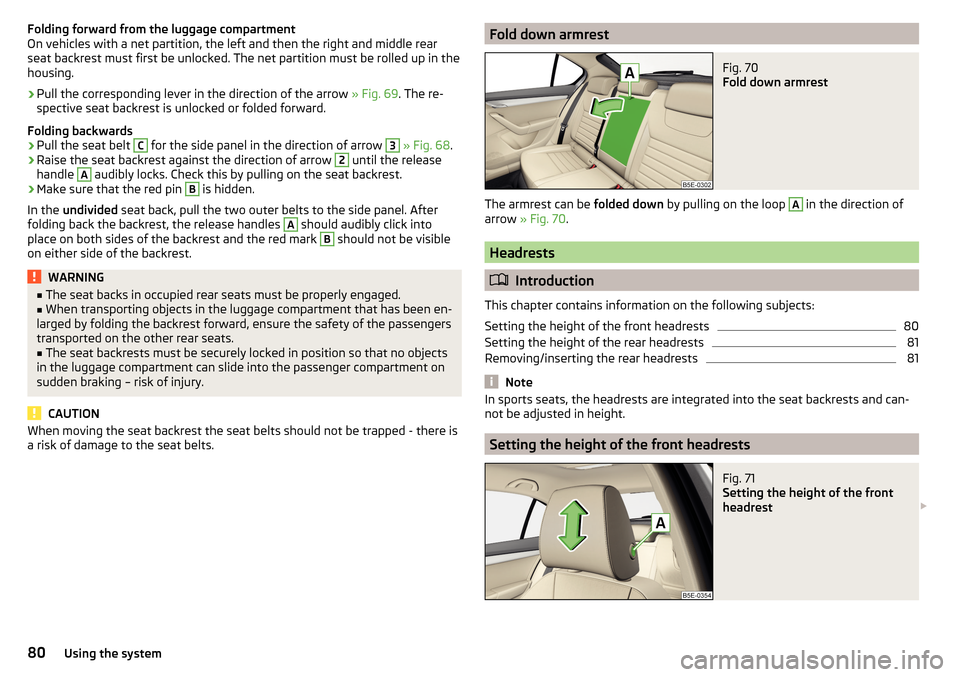
Folding forward from the luggage compartment
On vehicles with a net partition, the left and then the right and middle rear
seat backrest must first be unlocked. The net partition must be rolled up in the
housing.›
Pull the corresponding lever in the direction of the arrow » Fig. 69. The re-
spective seat backrest is unlocked or folded forward.
Folding backwards
›
Pull the seat belt
C
for the side panel in the direction of arrow
3
» Fig. 68 .
›
Raise the seat backrest against the direction of arrow
2
until the release
handle
A
audibly locks. Check this by pulling on the seat backrest.
›
Make sure that the red pin
B
is hidden.
In the undivided seat back, pull the two outer belts to the side panel. After
folding back the backrest, the release handles
A
should audibly click into
place on both sides of the backrest and the red mark
B
should not be visible
on either side of the backrest.
WARNING■ The seat backs in occupied rear seats must be properly engaged.■When transporting objects in the luggage compartment that has been en-
larged by folding the backrest forward, ensure the safety of the passengers
transported on the other rear seats.■
The seat backrests must be securely locked in position so that no objects
in the luggage compartment can slide into the passenger compartment on
sudden braking – risk of injury.
CAUTION
When moving the seat backrest the seat belts should not be trapped - there is
a risk of damage to the seat belts.Fold down armrestFig. 70
Fold down armrest
The armrest can be folded down by pulling on the loop
A
in the direction of
arrow » Fig. 70 .
Headrests
Introduction
This chapter contains information on the following subjects:
Setting the height of the front headrests
80
Setting the height of the rear headrests
81
Removing/inserting the rear headrests
81
Note
In sports seats, the headrests are integrated into the seat backrests and can-
not be adjusted in height.
Setting the height of the front headrests
Fig. 71
Setting the height of the front
headrest
80Using the system
Page 83 of 324

›To
adjust the height , hold the locking button A and move the rest in the de-
sired direction » Fig. 71.
Setting the height of the rear headrests
Fig. 72
Setting the height of the back headrest
›
Grasp the headrest and move upwards in the direction of arrow
1
» Fig. 72 .
›
To move the headrest down, press the securing button
A
in the direction of
arrow
2
and hold it down while pressing the headrest in the direction of ar-
row
3
.
Removing/inserting the rear headrests
Fig. 73
Removing/inserting the rear headrests
Before removing/inserting the headrests, fold the corresponding seat backrest
slightly forward » page 79.
›
To remove the headrest, pull it out of the seat backrest up to the stop.
›Hold the locking button A in the direction of arrow 1, at the same time us-
ing a flat screwdriver with a max. width of 5 mm to press the locking button
in the opening B
in the direction of arrow
2
and pull out the rest in the di-
rection of arrow
3
» Fig. 73 .
›
To insert the headrest, push the headrest into the seat backrest in the direc-
tion of arrow
4
until the locking button clicks into place.
Seat heaters
Fig. 74
Buttons for heating the front seats/rear seats
The seat backrests and surfaces of the front seats and the outer rear seats
can be heated electrically.
Seat heating buttons » Fig. 74
Left seat heating
Right seat heating
›
To turn on the heating to max, press the key
or
button.
By repeatedly pressing the button, the heat is turned down until it is com-
pletely switched off . The level of the seat heating is indicated by the number
of illuminated warning lights underneath / in the button.
The seat heating only operates when the engine is running.
When the ignition is switched off, the seat heating / ventilation is also switch-
ed off. if the engine is started again within 10 minutes, then the driver's seat
heating / ventilation is switched on again automatically according to the set-
ting before switching off the ignition.
81Seats and head restraints
Page 84 of 324

WARNINGIf you are sensitive to pain and/or temperature, e.g. through medication,
paralysis or because of chronic illness (e.g. diabetes), we recommend not to
use the seat heating. If the seat heating is used, we recommend to make
regular breaks in your journey when driving long distances, so that the
body can recuperate from the stress of the journey. Please consult your
doctor, who can evaluate your specific condition.
CAUTION
The following instructions must be observed to avoid damage to the seats.■Do not kneel on the seats or otherwise apply concentrated pressure to them.■
Do not switch on the heating for unoccupied seats.
■
Do not switch on the heating for seats which have objects on them (e.g. a
child seat, bag or similar).
■
Do not switch on the heating for seats which have seat covers or protective
covers on them.
Note
If the on-board voltage decreases, the seat heating switches off automatically
» page 258 , Automatic consumer shutdown - Discharge protection of the ve-
hicle battery .Useful features
Interior fittings
Introduction
This chapter contains information on the following subjects:
Ticket holder
83
Storage compartment on the driver's side
83
Stowage compartments in the doors
83
Storage compartment in the front centre console
84
Phonebox
84
USB and AUX input
85
Cup holders
85
Waste container
85
Multimedia holder
86
Storage compartment under the front arm rest
86
Glasses compartment
87
Storage compartment on the front passenger side
87
Storage compartment for umbrella
87
Clothes hook
88
Storage pockets on the rear sides of the front seats
88
Storage compartment in the rear centre console
88
Long cargo channel
89
Removable through-loading bag
89WARNING■ Do not place anything on the dash panel. These objects might slide or fall
down when driving and may distract you from concentrating on the traffic –
There is a risk of an accident!■
Make sure that while driving no objects can enter the driver's footwell -
There is a risk of an accident!
■
Do not transport any objects on the front passenger seat except objects
(e.g. child safety seat) provided for this purpose – risk of accident!
■
No objects should be placed in the storage compartments nor in the
drinks holders; the vehicle occupants could be endangered if there is sud-
den braking or the vehicle collides with something.
82Using the system
Page 85 of 324

WARNING (Continued)■For safety reasons, lockable storage compartments should be closed
while driving - there is a risk of injury from the opened lid or through the
loose objects in the compartment.■
Make sure no objects protrude from the storage compartments - There is
a risk of injury!
■
Do not exceed the permissible loads for the storage compartments and
pockets - There is risk of injury and risk of damage to the compartments
and pockets!
■
Ash, cigarettes, cigars etc. should only be stored in the ashtray - There is
a risk of fire/burns!
■
The storage compartments and the waste containers are not a substitute
for the ashtray and must also not be used for such purposes – There is a
risk of fire!
CAUTION
Do not place any large or sharp objects in the storage compartments and pock-
ets - there is a risk of damage to the compartments and pockets.
Ticket holder
Fig. 75
Ticket holder
Read and observe and on page 82 first.
The ticket holder » Fig. 75 is provided for the holding and displaying e.g. car
park tickets.
Storage compartment on the driver's sideFig. 76
Opening the storage compart-
ment
Read and observe and on page 82 first.
›
To open , lift the handle and fold out the compartment in the direction of the
arrow » Fig. 76 .
›
To close , swing the lid against the direction of the arrow until it audibly clicks
into place.
Stowage compartments in the doors
Fig. 77
Storage compartments: in the front door/in the rear door
Read and observe
and on page 82 first.
Storage compartments » Fig. 77
Storage compartment
Bottle holder with a capacity of max. 1.5 l
Bottle holder with a capacity of max. 0.5 l
ABC83Useful features
Page 86 of 324
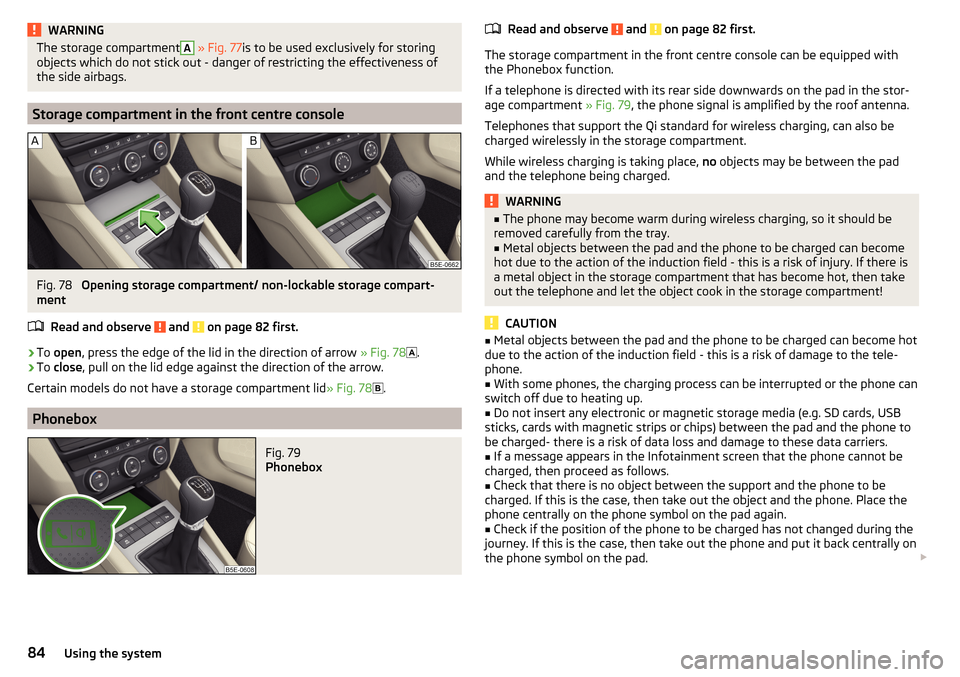
WARNINGThe storage compartmentA » Fig. 77 is to be used exclusively for storing
objects which do not stick out - danger of restricting the effectiveness of
the side airbags.
Storage compartment in the front centre console
Fig. 78
Opening storage compartment/ non-lockable storage compart-
ment
Read and observe
and on page 82 first.
›
To open , press the edge of the lid in the direction of arrow » Fig. 78
.
›
To close , pull on the lid edge against the direction of the arrow.
Certain models do not have a storage compartment lid » Fig. 78
.
Phonebox
Fig. 79
Phonebox
Read and observe and on page 82 first.
The storage compartment in the front centre console can be equipped with
the Phonebox function.
If a telephone is directed with its rear side downwards on the pad in the stor-
age compartment » Fig. 79, the phone signal is amplified by the roof antenna.
Telephones that support the Qi standard for wireless charging, can also be
charged wirelessly in the storage compartment.
While wireless charging is taking place, no objects may be between the pad
and the telephone being charged.
WARNING■ The phone may become warm during wireless charging, so it should be
removed carefully from the tray.■
Metal objects between the pad and the phone to be charged can become
hot due to the action of the induction field - this is a risk of injury. If there is
a metal object in the storage compartment that has become hot, then take
out the telephone and let the object cook in the storage compartment!
CAUTION
■ Metal objects between the pad and the phone to be charged can become hot
due to the action of the induction field - this is a risk of damage to the tele-
phone.■
With some phones, the charging process can be interrupted or the phone can
switch off due to heating up.
■
Do not insert any electronic or magnetic storage media (e.g. SD cards, USB
sticks, cards with magnetic strips or chips) between the pad and the phone to
be charged- there is a risk of data loss and damage to these data carriers.
■
If a message appears in the Infotainment screen that the phone cannot be
charged, then proceed as follows.
■
Check that there is no object between the support and the phone to be
charged. If this is the case, then take out the object and the phone. Place the
phone centrally on the phone symbol on the pad again.
■
Check if the position of the phone to be charged has not changed during the
journey. If this is the case, then take out the phone and put it back centrally on
the phone symbol on the pad.
84Using the system
Page 87 of 324
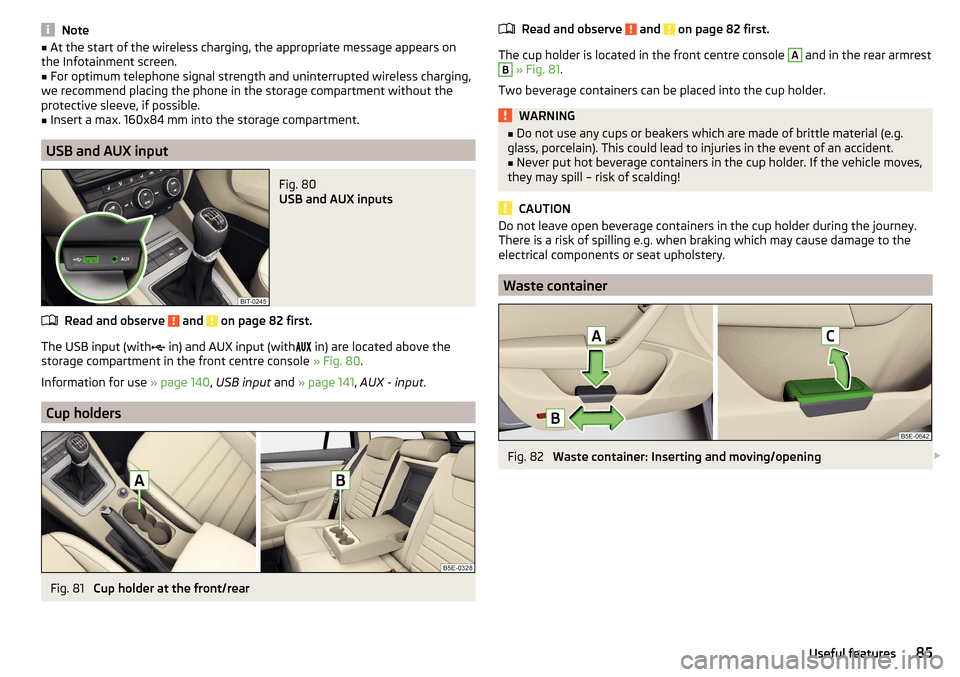
Note■At the start of the wireless charging, the appropriate message appears on
the Infotainment screen.■
For optimum telephone signal strength and uninterrupted wireless charging,
we recommend placing the phone in the storage compartment without the
protective sleeve, if possible.
■
Insert a max. 160x84 mm into the storage compartment.
USB and AUX input
Fig. 80
USB and AUX inputs
Read and observe and on page 82 first.
The USB input (with
in) and AUX input (with
in) are located above the
storage compartment in the front centre console » Fig. 80.
Information for use » page 140, USB input and » page 141 , AUX - input .
Cup holders
Fig. 81
Cup holder at the front/rear
Read and observe and on page 82 first.
The cup holder is located in the front centre console
A
and in the rear armrest
B
» Fig. 81 .
Two beverage containers can be placed into the cup holder.
WARNING■ Do not use any cups or beakers which are made of brittle material (e.g.
glass, porcelain). This could lead to injuries in the event of an accident.■
Never put hot beverage containers in the cup holder. If the vehicle moves,
they may spill – risk of scalding!
CAUTION
Do not leave open beverage containers in the cup holder during the journey.
There is a risk of spilling e.g. when braking which may cause damage to the
electrical components or seat upholstery.
Waste container
Fig. 82
Waste container: Inserting and moving/opening
85Useful features
Page 88 of 324

Fig. 83
Replacing the bags
Read and observe
and on page 82 first.
The waste container can be inserted into the slots in the doors.
Insert waste container
›
Position the waste container at the front edge of the slot.
›
Push the waste container to the back in the direction of the arrow
A
» Fig. 82 .
›
Push the waste container as required in the direction of arrow
B
.
Remove the waste container
›
Remove the waste container in the opposite direction to the arrow
A
» Fig. 82 .
Open/close waste container
›
Lift the lid in the direction of arrow
C
» Fig. 82 .
Closing takes place in reverse order.
Replace bags
›
Remove the waste container from the slot.
›
Press the two locking lugs on the frame in the direction of arrow
1
» Fig. 83 .
›
Pull the bag together with the frame down in the direction of arrow
2
.
›
Remove the bag from the frame.
›
Pull the new bag through the frame and pull it over the frame in the direction
of arrow
3
.
›
Place the bag with the frame in the direction of arrow
4
into the container
body, so that the two lugs engage audibly on the frame.
Note
We recommend that you use 20x30 cm bags.Multimedia holderFig. 84
Multimedia holder
Read and observe and on page 82 first.
The multimedia holder » Fig. 84 is provided for storing mobile phones, MP3
players etc.
Storage compartment under the front arm rest
Fig. 85
Opening the storage compart-
ment
Read and observe and on page 82 first.
›
To open Pull the arm on the handle
A
in direction of arrow » Fig. 85.
›
To close , lift the armrest in the direction of arrow until the stop and then fold
down against the direction of arrow.
86Using the system
Page 89 of 324

Glasses compartmentFig. 86
Opening the glasses storage box
Read and observe and on page 82 first.
›
To open , press on the outer edge of the glasses compartment in area
A
.
The compartment folds in the direction of the arrow » Fig. 86.
›
To close , swivel the compartment against the direction of the arrow until it
audibly clicks into place.
CAUTION
■ Do not put any heat-sensitive objects in the glasses storage box - with high
temperatures there is risk of damage.■
The box must be closed before leaving and locking the vehicle – risk of im-
pairment to the functions of the anti-theft alarm system.
Storage compartment on the front passenger side
Fig. 87
Open storage compartment / close storage compartment and
open air supply
Read and observe and on page 82 first.
The storage compartment is equipped with an interior light (this is illuminated
when the parking lights / low beam are switched on), a pen/card holder and an air outlet.
Storage compartment
›
To open , pull the handle
A
in the direction of arrow
1
and fold the cover in
the direction of arrow
2
» Fig. 87 .
›
To close , swivel the cover in the direction of arrow
3
until it audibly clicks
into place.
Air supply
›
To open , turn the rotary switch until it stops in the position
» Fig. 87
.
›
To close , turn the rotary switch until it stops in the position
.
The temperature of the storage compartment supplied with air is dependent
on the setting in the air conditioning.
Storage compartment for umbrella
Fig. 88
Opening the storage compart-
ment
Read and observe and on page 82 first.
The storage compartment under the passenger seat is used for storing an um-
brella.
›
To open , pull the handle in direction of arrow
1
pull and open the compart-
ment in the direction of arrow
2
» Fig. 88 .
›
To close , screw in the lid in the opposite direction of arrow
2
until it audibly
clicks into place.
CAUTION
Never store a wet umbrella in the storage compartment - there is a risk of
damage to the umbrella. 87Useful features
Page 90 of 324
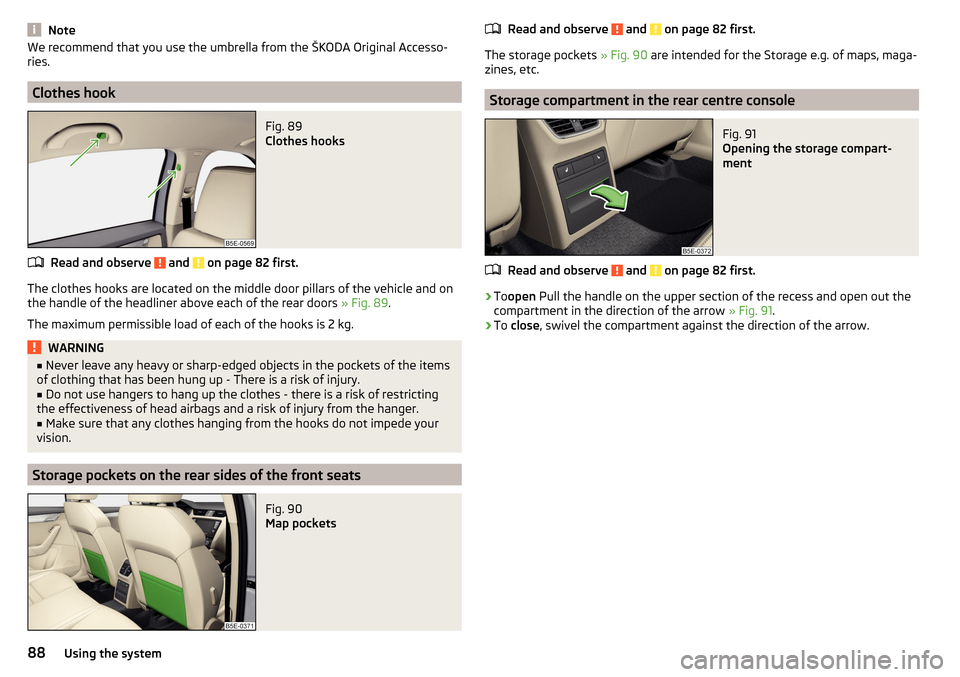
NoteWe recommend that you use the umbrella from the ŠKODA Original Accesso-
ries.
Clothes hook
Fig. 89
Clothes hooks
Read and observe and on page 82 first.
The clothes hooks are located on the middle door pillars of the vehicle and on
the handle of the headliner above each of the rear doors » Fig. 89.
The maximum permissible load of each of the hooks is 2 kg.
WARNING■ Never leave any heavy or sharp-edged objects in the pockets of the items
of clothing that has been hung up - There is a risk of injury.■
Do not use hangers to hang up the clothes - there is a risk of restricting
the effectiveness of head airbags and a risk of injury from the hanger.
■
Make sure that any clothes hanging from the hooks do not impede your
vision.
Storage pockets on the rear sides of the front seats
Fig. 90
Map pockets
Read and observe and on page 82 first.
The storage pockets » Fig. 90 are intended for the Storage e.g. of maps, maga-
zines, etc.
Storage compartment in the rear centre console
Fig. 91
Opening the storage compart-
ment
Read and observe and on page 82 first.
›
To open Pull the handle on the upper section of the recess and open out the
compartment in the direction of the arrow » Fig. 91.
›
To close , swivel the compartment against the direction of the arrow.
88Using the system